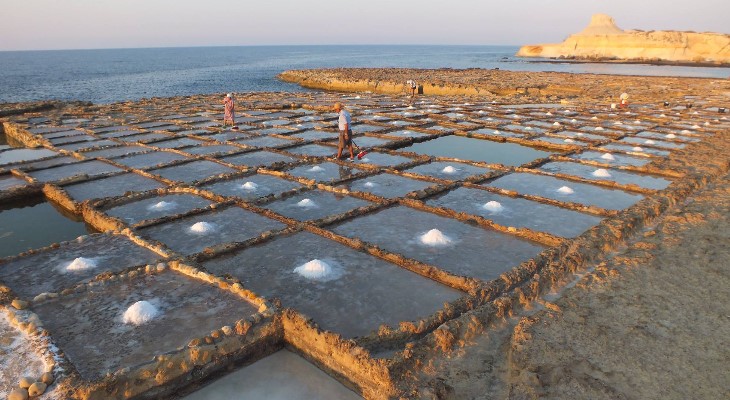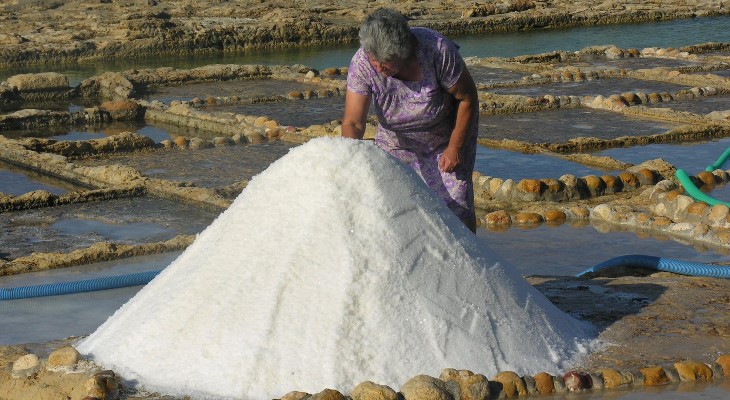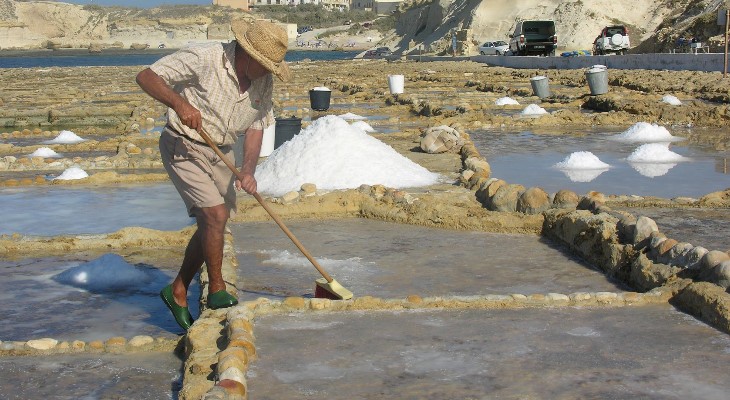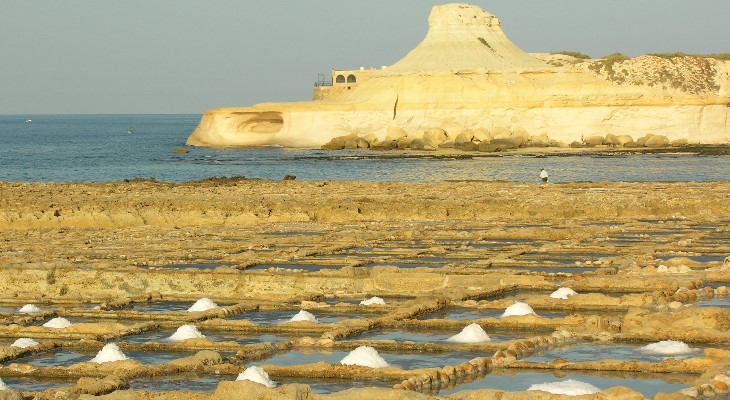The most authentic product of the Maltese Islands is still made with the same centuries old methods using three simple ingredients: sea, sun & wind. And a lot of dedication.
As dawn breaks and the world slowly awakens, Josephine Xuereb is already busy at work by the water’s edge, brush in hand ready to sweep 150 rock-cut salt pans just as her parents, grandparents and ancestors have done for generations.
Josephine and her husband David, together with her parents Leli and Rose Cini, are among the last of an ever-dwindling number of salt harvesters. Her family have been tending these salt pans along the coast of Xwejni on the island of Gozo since 1860.
It is back-breaking work with no help from modern machinery. It is pure manual labour, a lot of sweat and a deep-rooted passion that can only be borne out of an unconditional love for nature.
“It is very intensive and laborious work but it is very rewarding,” admits Josephine, who has been helping her parents at the salt pans ever since she was a little girl. “This precious Gozitan raw material, produced with the natural ingredients of the sun, the wind and the sea, is a purely authentic Maltese product, the gift of the Mediterranean sea.”

Xwejni Salt Pans Leli tal-Melh (Cini)
Sea salt harvesting is probably Malta’s oldest industry, dating back to Roman times. Sea salt was always considered to be a highly-prized ingredient, and was also used as a form of currency, hence the word “salary” and the expression “worth one’s salt”. The Maltese word for salt is melh and the popular northern town of Mellieha (meaning salt producing place) got its name from the salt that was produced at the ancient salt lake at Ghadira bay (ghadira means lake) back in Arab times.
The northern coastline of Gozo, past Qbajjar bay, is a chequerboard of salt pans stretching over 3km. Most are now unused but some, like the ones owned by Josephine’s family, are still very much in production, and have been handed down through generations of the same family, producing an exceptional sea salt rich in minerals.
Salina just outside Bugibba is the main production area for sea salt in Malta, and following restoration by the EU’s rural Development fund in 2015, it produced 20 tonnes of salt last year, with potential to generate more salt than all the other sites in Malta put together. Other salt pans can been seen along the southern shores in Marsascala, Zonqor Point, Delimara, Xghajra and Birzebbuga.
As salt harvesting depends entirely on the weather, it takes place during the scorching summer months between May and September, after the sun has “done its magic” as Josephine puts it.

Xwejni Salt Pans Leli tal-Melh (Cini)
“A typical day for me begins at the crack of dawn. If salt collection is taking place in the morning, by sunrise I am down at the salt pans to pick up my brush to start sweeping the pans. I fill the buckets with salt and carry them on my shoulders to make a heap of white gold. Later on, sometimes in the afternoon, we use hose pipes to refill the pans, to prepare for another collection,” explains Josephine.
The process is very simple and has not changed for centuries. Sea water fills the pans, and the heat of the sun evaporates the water leaving behind the salt crystals which are then collected, dried some more with the help of the wind and then bagged. Simple as that. No additives, no machinery, nothing else that could corrupt its purity.
But as a product of Mother Nature, salt harvesting also relies on the clemency of the weather. “It depends entirely on Mother Nature, which sometimes is very difficult. The wind, the climate and the heat all play a very important part,” says Josephine. “Two years ago, there was a big storm during peak season in July and the sea swept everything away. We had to stop collecting. Summer for us is short, so that year by October our stock was completely finished.”

Xwejni Salt Pans Leli tal-Melh (Cini)
Salt is literally money for Josephine and her family, and she is very much aware of how much she is indebted to nature. “I appreciate more how the simplest and most genuine things are the most extraordinary in life. Nowadays everyone takes things for granted. We do not have time to appreciate how and where our food comes from. Nature turns the sea water into salt, and I see that happen in front of my very eyes. I also see it taken away in storms when the sea sweeps everything away. Afterwards it is very difficult to re-generate the stock.”
It is understandable that Josephine feels philosophical about salt harvesting. She never calls it a business. It is simply her way of life, one that has defined her and her family for generations. “My parents Leli and Rose have been tending the salt pans lovingly for these last 50 years. Every summer, they harvest their crop with enormous passion and dedication. Our share of these salt pans at Xwejni has been chiselled by my ancestors from my mother’s side. When my parents got married in 1969 my father revived the salt trade and cultivated it. My parents always worked silently together. It gives me great satisfaction to work next to my beloved parents. Together we feel a huge sense of commitment and perseverance. While working together, sometimes in the scorching sun, we share our pain and laughter.”
And will her children follow in her footsteps and continue the salt harvesting tradition? Josephine is hopeful. "My children are grown up and they love the tradition too. They seem interested, but right now I can't say if they will follow or not. I believe in destiny so right now I cannot give you a proper answer. They help out, but at the moment they are busy finishing their higher education," she concedes.

Xwejni Salt Pans Leli tal-Melh (Cini)
Salt in local cuisine
Salt is a key ingredient in any kitchen, but Gozitan sea salt, rich in minerals, is prized for its purity and flavour. It is used to make sun-dried tomatoes, to preserve locally grown capers and to make sheep’s milk cheeslets (gbejniet). It is also essential in curing olives. Mixed with fennel seeds, sea salt is ideal to flavour any roasts especially potatoes, sliced in thick rounds and baked on a bed of onions.
Culinary scientist and co-founder of the Mediterranean Culinary Academy Michael Camilleri highlights the importance of using good quality salt in your cooking which is also sustainable: "Salt is the most important ingredient in your kitchen, so when you try to source a sustainable salt, naturally evaporated sea salt is generally the way to go. Other methods for harvesting salt such as mining or evaporating (by boiling) subterranean brine can be somewhat less environmentally friendly than simply relying on the sun to evaporate water and leave behind the salt."
He explains that chefs generally choose two types of salt, an all-purpose seasoning salt and a finishing salt which is usually a larger, finer crystal. "It doesn’t just add salinity but it’s also a textural element — larger crystals can be quite crunchy and thinner flakes can be nice and crispy. We opt to buy local sea salts for both purposes as they’re readily available, consistent and we are always happy to support local industries."
And what is a chef's favourite way of using sea salt? On hobz biz-zejt, of course. "Hobz biz-zejt with some large, flaky, and crunchy crystals of Xwejni salt is certainly a great way to try it out. It’s great for finishing off barbecued meats or fish. I love salty chocolate so I’ll usually add some to finish a chocolate souffle or mousse," reveals Michael.
While you can find Gozitan sea salt in supermarkets or even souvenir shops, nothings beats buying a bag of that precious “white gold” direct from the makers. Pop over to Xwejni to meet Josephine, Rose or Leli tal-Melh any weekday during summer to watch them work at the pans. They will be more than happy to show you how the age-old process of salt harvesting works and “how the sun does its magic”.